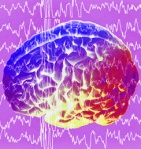Human brain communicates through electrical signals and its language can be recorded as electroencephalogram (EEG). The recorded signal has the form of cyclic waveforms and is called brainwave pattern. It is an honest representation of what goes on in the brain – how you are feeling and what you are thinking. You suddenly meet a person you hate; your brainwaves will change instantly to reflect your feelings. You take a break to enjoy beer and music; you will have another wave pattern dominating your brain.
It is possible to adjust your brainwaves to your advantage for desired results, just as you adjust brightness of the room using a dimmer switch. Thanks to imaging techniques, it is now possible to watch your brainwaves perform. But first you should know what various brainwaves indicate or reflect.
Beta waves: 13-30 cycles per second (Hz)
In the normal waking state the beta brainwaves dominate the brain landscape for most people. The usual frequency range is 13-30 Hz, which is associated with alertness, concentration and arousal. They help you in high performance, logical thinking and problem solving as they represent high mental energy. But if used continuously, you run the risk of mere thinking deeply without achieving much, so best to have periods of frequent rest and stillness.
Brainwaves beyond 30 Hz signify emotional distress, uneasiness and anxiety. These high-end waves are often indicative of feelings of separation, “fight or flight” response. Sometimes these high frequency waves are also labeled as gamma waves.
Alpha waves: 8-13 Hz
Brainwave frequency begins to slow down as soon as we close our eyes and relax. It is a state of relaxed focus, light trance, visualization, and vivid imagination. Some view it as escape from reality. Too much alpha activity may be termed escapism and too little turns you into human machine without originality or vision. When alpha waves are dominant, you also see release of calming neuro-chemicals like serotonin, which is reduced by stress and anxiety.
Alpha waves towards the upper end are associated with concentrative state of mind like when you are absorbed in a book. The lower end alpha waves are dominant during pre-sleep or pre-waking drowsiness. These are also predominant when you are feeling peace and contentment or doing meditation.
Theta Waves: 4-8 Hz
Theta waves further slow you down. This is a very important state because it is associated with enhanced creativity, deep relaxation, healing, memory, and when we synthesize disparate pieces of information leading sudden realization or insight. It is also predominant during dreaming in the REM sleep. According to most psychologists the theta state is the doorway to the sub-conscious mind. Theta state increases the production of catecholamines that are vital for learning and memory.
Delta waves: 0.1 – 4 Hz
This represents the state of dreamless deep sleep. Carl Jung describes this state as having a feeling of oneness or unity shared by all humans. Here you can have a deep trance-like, non-physical state with loss of body awareness.
It is possible to be alert in the delta state provided there is presence of some alpha or beta activity. This state is also associated with empathy, but too much of it can make you own others’ miseries. People, who can read others’ mind, engage more in delta waves.
These categories are not mutually exclusive; in fact, all four waves are present all the time but some frequency state dominates. However, the beta state dominates most of the time for most people as it reflects activities of wakefulness. It should also be clear why relaxed people are more innovative and creative.
You may also like to read
Synchronization of Brain Hemispheres
How to Entrain Brain Waves

